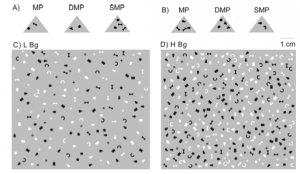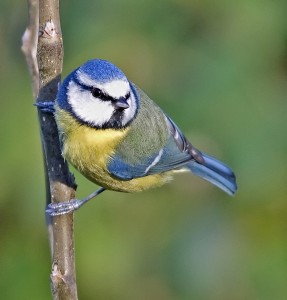Many animals use protective coloration as a means of avoiding predation. For many species, e.g cuttlefish and flatfish, this protective coloration takes the form of crypsis, a mechanism by which an organism use body color and patterns to match their background and decrease risk of detection.
Previous studies have examined some aspects of cryptic defense, in particular focusing on the coloration of the prey and its similarity or difference to its background. However, few studies have addressed the effects of the visual properties of the background itself on prey detection. Some recent research suggests that the amount of visual noise in the background impacts ease of prey detection. For example, a study by Duncan and Humphreys (1989) suggested that human shape detection is influenced by both similarity of the target to its background and the variability and number of background distractors. In nature, visual backgrounds containing objects such as vegetation or rocks can vary greatly element density, thus potentially influencing prey detectability in these different visual environments.
A new study by Dimitrova and Merilaita (2014) focused on the effect of the density of background elements on prey concealment when presented to blue tit birds, a visually hunting avian species that imposes selection pressure on its insect prey. In the experiment, the birds were presented with backgrounds of different element density, and prey items with patterns that either matched the shape and density of the background, matched the shape but not the density, or matched the density but not the shape. The time it took for the birds to detect the prey item was used as an indicator of detection difficulty.
The Eurasian Blue Tit (Cyanistes caeruleus)
The results showed that the blue tits took significantly longer to identify prey items on the higher density background than the low density one, indicating that an increase in background complexity does in fact make prey detection more difficult. Additionally, the prey item that matched both shape and density of the background was more difficult to detect than the only-shape-matching item and the only-density-matching prey.
 Examples of the prey categories and the backgrounds. Prey category MP had both background-matching element density and shapes, DMP had matched element density but one mismatching element shape, and SMP had only matching element shapes but mismatched element density relative to the background. One example of the prey items from each of the 3 categories (A) in the low-density background and (B) in the high-density background is shown. For each prey item, the matching and mismatching elements were randomly chosen among the shapes depicted in Figure 1A, B, after which they were randomly placed and oriented. Samples of the patterning of (C) the low-density background (LBg) and (D) the high-density background (HBg) are shown.
Examples of the prey categories and the backgrounds. Prey category MP had both background-matching element density and shapes, DMP had matched element density but one mismatching element shape, and SMP had only matching element shapes but mismatched element density relative to the background. One example of the prey items from each of the 3 categories (A) in the low-density background and (B) in the high-density background is shown. For each prey item, the matching and mismatching elements were randomly chosen among the shapes depicted in Figure 1A, B, after which they were randomly placed and oriented. Samples of the patterning of (C) the low-density background (LBg) and (D) the high-density background (HBg) are shown.
The effect of visual background properties has important evolutionary implications. Changes in visual aspects of the environment, including object density, could create selective pressures on prey organism attempting to avoid predation. For example, prey items living in complex visual environments favoring concealment seem to tend towards evolution of cryptic coloring, while prey in more open environments are more likely to evolve warning coloration.
The findings of this study indicate effective background matching requires prey to possess elements that not only match the shape and color of background elements, but also the density and complexity of the elements. These results provide a greater understanding of visual systems of avian predators, which can perhaps be used as a model for other organisms, and provide insight into factors that influence effective camouflage techniques.
Duncan J, Humphreys GW. 1989. Visual search and stimulus similarity. Psychol Rev. 96:433–458.
Dimitrova, M., Merilaita, S. 2014. Hide and seek:properties of prey and background patterns affect prey detection by blue tits. Behavioral Ecology. 25: 402-408

